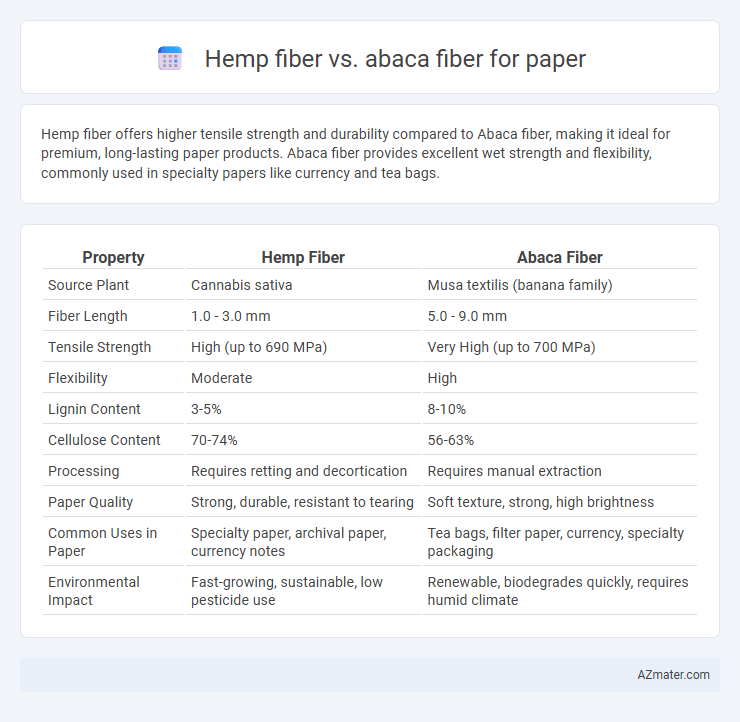Hemp fiber offers higher tensile strength and durability compared to Abaca fiber, making it ideal for premium, long-lasting paper products. Abaca fiber provides excellent wet strength and flexibility, commonly used in specialty papers like currency and tea bags.
Table of Comparison
| Property | Hemp Fiber | Abaca Fiber |
|---|---|---|
| Source Plant | Cannabis sativa | Musa textilis (banana family) |
| Fiber Length | 1.0 - 3.0 mm | 5.0 - 9.0 mm |
| Tensile Strength | High (up to 690 MPa) | Very High (up to 700 MPa) |
| Flexibility | Moderate | High |
| Lignin Content | 3-5% | 8-10% |
| Cellulose Content | 70-74% | 56-63% |
| Processing | Requires retting and decortication | Requires manual extraction |
| Paper Quality | Strong, durable, resistant to tearing | Soft texture, strong, high brightness |
| Common Uses in Paper | Specialty paper, archival paper, currency notes | Tea bags, filter paper, currency, specialty packaging |
| Environmental Impact | Fast-growing, sustainable, low pesticide use | Renewable, biodegrades quickly, requires humid climate |
Introduction to Hemp and Abaca Fibers
Hemp fiber, derived from the stalks of the Cannabis sativa plant, is known for its long, strong, and durable cellulose fibers, making it ideal for high-quality, sustainable paper production. Abaca fiber, obtained from the leaf stalks of the Musa textilis plant native to the Philippines, offers exceptional tensile strength and resistance to saltwater, commonly used in specialty papers and currency notes. Both fibers are renewable and biodegradable, with hemp providing a faster growth cycle and abaca excelling in unique fiber properties suitable for niche applications.
Botanical Origins and Cultivation
Hemp fiber, derived from the stalks of *Cannabis sativa*, thrives in temperate climates with a growing cycle of 90-120 days, requiring minimal pesticides and offering high yield per hectare. Abaca fiber, sourced from *Musa textilis*, a banana plant native to the Philippines, flourishes in tropical regions with humid conditions and requires longer maturation periods of 9-12 months. Both fibers contribute to sustainable paper production, but hemp's rapid growth and lower resource demands contrast with abaca's superior tensile strength and natural resistance to saltwater damage.
Fiber Extraction and Processing Techniques
Hemp fiber extraction for paper involves retting, decortication, and mechanical or chemical pulping, yielding long, strong fibers ideal for durable paper products. Abaca fiber extraction uses water retting followed by manual stripping and mechanical beating, producing highly flexible and lustrous fibers suited for specialty papers. Processing hemp fibers typically requires more chemical treatment to break down lignin, whereas abaca fibers demand less processing due to their naturally lighter lignin content, impacting the overall fiber quality and environmental footprint.
Physical Properties Comparison
Hemp fiber exhibits higher tensile strength and greater elongation at break compared to Abaca fiber, making it more durable for paper applications requiring toughness. Abaca fiber offers superior brightness and a smoother surface finish, enhancing print quality in specialty paper products. Both fibers have distinct cellulose content levels, with Hemp containing approximately 70-75% cellulose, which contributes to its strength, while Abaca's cellulose content ranges around 45-60%, influencing its flexibility and softness.
Environmental Sustainability and Impact
Hemp fiber demonstrates superior environmental sustainability compared to Abaca fiber due to its rapid growth rate, requiring fewer pesticides and less water, resulting in a lower carbon footprint during cultivation. Abaca fiber, while biodegradable and naturally strong, demands intensive labor and contributes to deforestation risks in the Philippines, impacting local ecosystems negatively. Hemp's ability to regenerate soil and its higher cellulose content make it a more eco-friendly and efficient raw material for paper production.
Paper Strength and Durability
Hemp fiber exhibits superior tensile strength and durability compared to abaca fiber, making it highly suitable for producing strong, long-lasting paper products. The long, flexible hemp fibers create a dense fiber network, enhancing the paper's tear resistance and longevity. While abaca fiber offers good strength, it lacks the consistent durability and robustness found in hemp-based paper applications.
Printability and Surface Texture
Hemp fiber offers a smooth surface texture with high tensile strength, resulting in excellent printability and sharp image resolution for paper applications. Abaca fiber provides a coarse texture that enhances ink absorption but may reduce print clarity due to uneven surface fibers. Both fibers contribute to durability, yet hemp's finer texture supports superior print quality and consistent ink distribution in printing processes.
Cost and Commercial Availability
Hemp fiber offers a competitive cost advantage over abaca fiber due to its faster growth cycle and higher yield per acre, making it more economically viable for large-scale paper production. Abaca fiber, while prized for its strength and durability, often incurs higher costs attributed to labor-intensive harvesting and limited regional availability, primarily in the Philippines. Commercial availability of hemp fiber has expanded significantly with increased legalization and cultivation globally, whereas abaca remains region-specific, impacting its consistent supply for paper manufacturing.
Industrial Applications in Papermaking
Hemp fiber offers superior tensile strength and durability compared to abaca fiber, making it ideal for industrial papermaking applications requiring long-lasting, high-quality paper products like packaging and specialty papers. Abaca fiber, known for its exceptional flexibility and resistance to saltwater, excels in producing strong paper used in currency and tea bags, where resilience and fine texture are critical. Both fibers contribute to eco-friendly papermaking by reducing reliance on wood pulp, with hemp providing faster growth cycles and higher yield per hectare, enhancing sustainable industrial practices.
Future Prospects in the Paper Industry
Hemp fiber offers superior tensile strength and faster growth cycles compared to abaca fiber, making it a more sustainable and cost-effective raw material for the paper industry. Abaca fiber, known for its natural resistance to saltwater and durability, remains valuable for specialty papers and high-strength applications. Innovations in processing technologies are expected to enhance the integration of both fibers, promoting eco-friendly alternatives to traditional wood pulp in future paper manufacturing.

Infographic: Hemp fiber vs Abaca fiber for Paper
 azmater.com
azmater.com